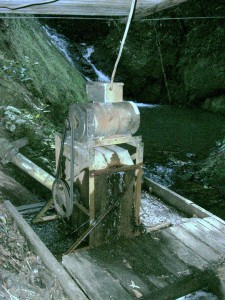
As I gradually come to in the morning and cock an eye to gauge the weather, I usually review what I might do in the day. Ah yes, going shopping today and an appointment in Atherton at 10 am. A few more press-ups with the eyelids then stumble out of bed and totter off to the shower. No alarm clock and no hurry in my daily rituals, as if I have something I must do, it is generally in the middle of the day. Part of my ritual is checking the rain gauge in between an orange juice and some cereal. Only 11 mm, just a dribble. Then as I pass the power system control cabinet, I notice a slight flickering of a light bulb. An old incandescent bulb specially kept from ancient times to indicate how much surplus power I have and where it is going. From experience, there are 3 reasons it might flicker.
1) Slow rhythmic flicker probably the generator drive belts a bit slack and flopping about. Ignore.
2) Fast rhythmic flicker might be the governor ‘hunting’, and a slight twist of a knob to alter the volts just a bit will fix that.
3) Fast irregular flicker probably the brushes on the generator sparking on the slip rings. This requires immediate attention as the sparks will quickly erode the slip rings into pits.
Oh bugger! Its an number 3! Scramble to the workshop and pack a bag of tools and off into the rain down to the generator at the bottom of the waterfall. Off with the cover and yes, No 1 pair of brushes lit up like a christmas tree so I shut off the water to the turbine and it goes all quiet … and dark. On a rainy day at the bottom of a waterfall in a rainforest, it is too dark to see what you are doing. Out with the LED headlight to look at the wreckage. Ah yes, the stainless steel springs that provide the right pressure for the brushes onto the slip ring have broken, making insufficient contact, making sparks, making erosion pits in the slip ring. Of course it is the pair of brushes most difficult to get at that require fixing.
So here I am, in the wet, in the dark, working in a space about the size of a mouse’s ear-hole, being eaten by leeches and absolutely assured that if I drop any tool or part into the rushing creek below, it will never be seen again. I’d complain to the engineer’s union, except I’m self employed. The first job is a lathe job to remove the pits in the slip rings. I pull all the brushes off the slip rings and start the turbine to use a scraper tool to eliminate the pits. The generator transformer is a handy tool post.
I manage to rebend the spring ends and reconnect and fit new brushes and fire it up again. Still a bit of sparking, maybe I can poke it to the right place with this screwdriver. Wham, bam, flash!!! The system short circuits and goes into over-speed as the load goes off and I frantically shut off the water. The moral of the story is don’t poke live wires and thank goodness for plastic screwdriver handles.
The brushes and callipers I have been repairing have been blown up and require more TLC than I though. About this time I rescheduled my 10 am appointment.
The generator in the picture has been working 24/7 for more than 30 years. It does have a few age-related problems. I am possibly thinking of contacting the makers of this machine with field test feedback. I find it satisfactory.
I managed to fit new springs, new brushes where required, and now expect another 10 years of trouble-free operation.
I made my appointment by 11 am.
To have your own power system is to feel empowered, literally, to feel independent. To feel confident and in charge of the things you require. That is the up side. The down side is that there is no one to phone and demand they come and fix it. It’s up to you.

Speak Your Mind